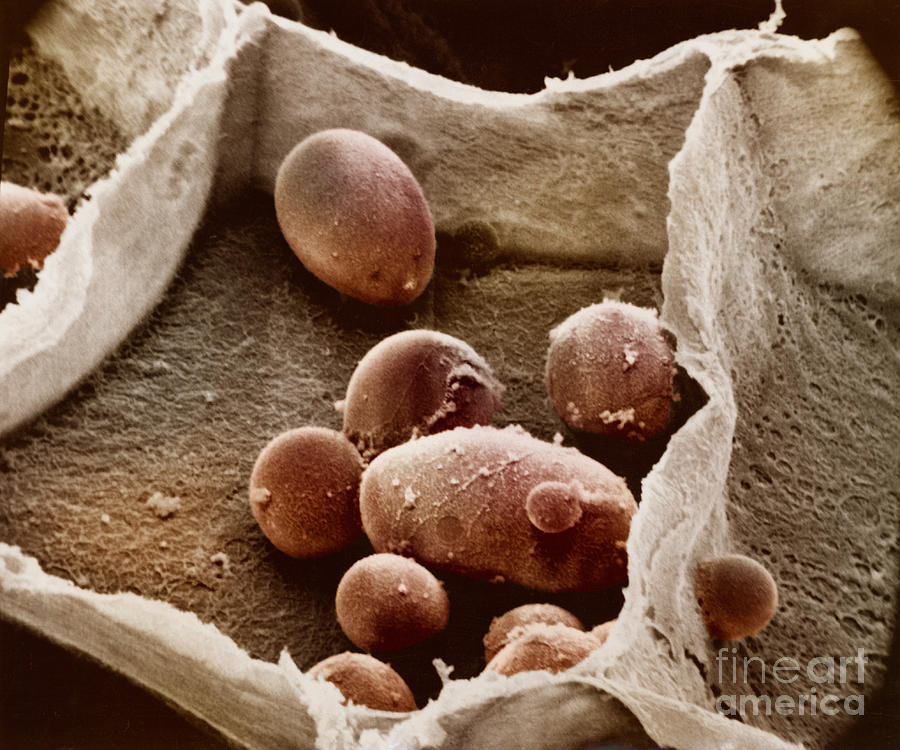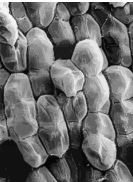INTRODUCTION
Russet (Idaho) potatoes are “high-starch” potatoes. Red potatoes are waxy or “low-starch” potatoes. The starch granules of a Russet potato are also larger than other types of potatoes. High-starch potatoes contain starch granules that are densely packed with amylose and amylopectin (most potatoes have between 20-30% amylose. Russet potatoes have more amylose that waxy potatoes). High-starch potatoes make fluffy baked potatoes, creamy mashed potatoes and french fries with a flaky interior, why is this?
 |
| image from: visualphotos.com |
These images below are of potato cells before and after cooking. Notice the small starch granules in the uncooked image and the swollen starch granules of the cooked image.
 |
 |
| Potato, uncooked. Compact starch granules. | Potato, cooked, swollen starch granules full of gelled starch. |
| http://www.ifrn.bbsrc.ac.uk/fb/tex/2_5.html | http://www.ifrn.bbsrc.ac.uk/fb/tex/2_6.html |

INGREDIENTS
- 1-3 large (0.75-1 pound) Russet Burbank (Idaho) baking potatoes. Weigh potatoes to be sure you have between 0.75-1 lb)
- Nonstick cooking spray
- 1/2 tablespoon olive oil
- 1 teaspoons salt
- 1/8 teaspoon cayenne (add the cayenne according to your preference for spicy foods)
- 1 teaspoons finely minced fresh rosemary
- 1/8 cup grated Parmesan
MATERIALS
- Sharp knife
- baking sheet
- 2-3 qt saucepan with lid
- wire mesh strainer or steaming basket that fits inside the saucepan but rests above the bottom
- clean kitchen towels
INSTRUCTIONS
When you see text in boldface blue font. You should document that step with a photo on your blog.
1. Place the potatoes, unpeeled, in the refrigerator for a day or two. When ready to cook, scrub but do not peel, and cut into fat “French-fry” sticks. Make sure your potato sticks are uniform in thickness. Rinse the cut “sticks” well under running water.
Letting the potatoes sit for a few days in the refrigerator converts some of the starch to free sugar molecules (glucose monomers) and makes the potatoes brown better in the oven. Although we won’t discuss sugar “browning” chemistry until unit 3, free sugars (like glucose monomers) are able to undergo chemical “browning” reactions while starch molecules (polymers of glucose) cannot undergo this chemistry.
The conversion of starch to sugar in a potato is a process catalyzed by enzymes and (paradoxically) actually occurs FASTER at colder temperatures – this is thought to be a strategy the potato uses to protect itself from frost damage.
Rinsing the potato under running water removes excess starch (that white filmy liquid that sticks to your knife and your hands). We want crispy fries, so we don’t want excess starch gelling on the outside of our potato sticks.
On your Blog
Take photos
- Of your finished oven fries that have been broken in half to show the interior.
Post a video in which…
- You taste test the oven fries. Is the interior soft and the exterior crunchy?
- Describe what went really well during your recipe.
- What would you change if you repeated this process again.
Answer the following questions:
- At what point during the recipe did the starch in the potato gel? What conditions were required?
- How might you expect this recipe to change if you used a “low-starch” (a.k.a. waxier) potato?
- How could you adapt what you learned here to making mashed potatoes?
